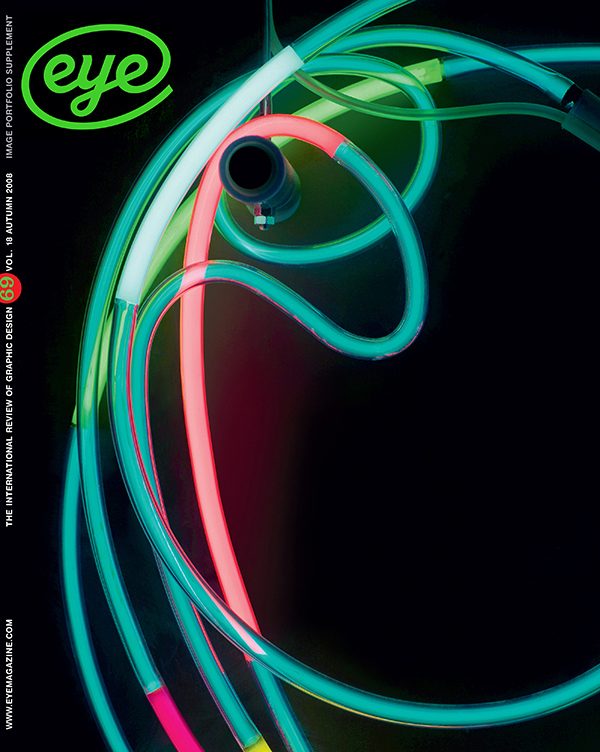Autumn 2008
Refreshing but inscrutably exotic
3030: New Graphic Design in China
Edited and designer by Javin Mo 3030 Press (Hong Kong) distributed in the UK by Art Data, £29.50 Reviewed by Steven RigleyNow that the Olympic Circus has finally rolled out of town, it is highly likely that most of us will be left vulnerable to some strain of China fatigue, what with all those column inches dedicated to human rights abuse, security and dope testing. Yet it remains an opportune moment to present a new generation of Chinese graphic designers. And given their government’s enviable investment in design education, both at home and abroad, there will be no shortage of interest from a student demographic eager for heroes.
3030: New Graphic Design in China brings together 30 designers, most of whom were born around the end of the Cultural Revolution (1966-76) and therefore roughly 30 years old. It is edited and art-directed by Hong Kong-based Javin Mo, who extends an impressive reach, gathering designers from thirteen different cities. Having grown up in British Hong Kong and worked in Italy, Javin is able to offer a degree of objectivity to his introduction, where he notes the liberating impact of the internet in releasing portals, blogs and new ideas upon young designers seeking to establish ‘a new sense of Chinese creative identity’.
This ‘new generation’ is fleshed out over the following pages by the writer Bono Lee in a short portrait of a typical Chinese student, who, as a product of the single child policy and the focus of affluent parents, seems to epitomise the ‘Little Emperor Syndrome’ while also a product of global monoculture: a young life digitally immersed in the all-too-familiar brands, bands and social networks. For those brought up on distant reports from foreign correspondents caught between grey tides of cyclists, the intention of this short cameo is clearly to dispel any lingering notion of China as a detached or backward nation.
The designers are each represented by a selection of work and a paragraph detailing their educational background and awards. While the career profiles conform to a similar pattern – educated in China and showered
in accolades – the actual work is, on first impression, refreshingly diverse, often beautifully crafted, and full of personality. However the enjoyment is soon lost in the pursuit for more information.
Hangzhou-based Jon Fong is introduced by two delicate typographic posters, which are captioned collectively as ‘Type’. Since the reproductions are quite small, it is impossible to establish whether these form part of a commission or a personal exploration. Similarly, the MEWE Design Alliance is represented by an intriguing mixed-format book, but the caption ‘Heilongiang Box-Qui Xiaofei’ is meaningful only to those familiar with the artist they created it for. Huang Yang’s visual identity for ‘InChina’ occupies three pages yet the caption neglects to inform who or what InChina actually is, and so the reader is left to speculate on what may be a branding exercise, a political campaign or a student prank. The Wide / Narrow book by designer and curator He Ming includes a stunning monochrome print of what appears to be a dilapidated road sign. Is it included merely because the object itself is wide?
And the muscular typography of Jiang Hua is literally lost without translation. It looks fabulous but what does it say? And so on.
Sadly, in the absence of any contextual information, the reader is left purely to ponder over images, making judgements based upon aesthetic novelty or finesse, choice of colour and use of space. There is, of course, a great western precedence for the exotic ‘picture book’ and so many will find inspiration in these pages, and others will delight in the opportunity for post-colonial plunder. The publishers might argue that it is intended to function merely as a showcase for those that deserve a wider audience. Perhaps so, but the sad irony is that these Chinese designers have not been given the opportunity to speak for themselves or offer any form of insight into the professional setting that they operate within.
Considering the surge of interest in cross-cultural design, the 3030 Press should be encouraged to consider further publications that begin to address the questions that quite naturally arise. Given the opportunity, how would the designers describe their education? Has there been any discernable break with the historic model of master / apprentice? Is plagiarism considered to be an act of respect? To what extent has exposure to western design influenced their own practice? Has this brought with it any particular tensions? Can they identify any characteristics of what may form an emerging ‘Chinese creative identity’? And western designers will be curious as to how all this is worked out on a professional level. How do they get their clients? Is ‘free-pitching’ a common practice, and what about fees?
Such essential background information would surely furnish deeper discussion that might, for instance, reflect upon the influence of Confucian thinking towards ‘individuality’ and ‘responsibility’, or consider whether creativity does indeed flourish from within an alternative political / economic model, such as a dictatorship.
The alternative is yet another picture book (volume 2) but that will be helping nobody.
Steve Rigley, designer and educator, Glasgow
First published in Eye no. 69 vol. 18, 2008
Eye is the world’s most beautiful and collectable graphic design journal, published for professional designers, students and anyone interested in critical, informed writing about graphic design and visual culture. It is available from all good design bookshops and online at the Eye shop, where you can buy subscriptions and single issues.

